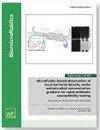控制代谢环境的微型培养平台
IF 2.4
4区 工程技术
Q2 BIOCHEMICAL RESEARCH METHODS
引用次数: 0
摘要
心脏是新陈代谢的 "杂食动物",会根据循环代谢物的不同调整能量来源。人体心脏器官组织是一种心脏壁的三维体外模型,是研究心脏生理和病理的有用工具。然而,心脏组织在体内会通过血流自然经受剪切应力和营养波动,而体外模型传统上是在静态培养基中培养的。这就需要定期刷新培养基,从而造成急性细胞紊乱和大量代谢通量。为了以更符合生理学的方式培养人体心脏器官组织,我们开发了一种用于 96 孔板培养的灌注生物反应器。所设计的生物反应器使用普通培养板和三维打印机就能轻松制作。它的开放式系统允许使用传统的分子生物学技术,避免了流动阻塞问题,并为取样和细胞检测提供了便利。我们假设,灌注培养能创造更稳定的环境,改善心脏功能和成熟度。我们发现,人体心脏器官组织会迅速产生乳酸,从而导致静态培养下这种代谢物的大幅波动。尽管如此,生物反应器培养中的培养基灌注和乳酸补充都没有改善心脏功能或成熟度。事实上,RNA 测序显示转录组几乎没有变化。这表明,在正常生理条件下,心脏器官组织对波动的环境条件具有很强的反应能力。总之,我们提供了一个建立易于使用的灌流系统的框架,该系统可适用于一系列小型化细胞培养系统。本文章由计算机程序翻译,如有差异,请以英文原文为准。
A miniaturized culture platform for control of the metabolic environment
The heart is a metabolic “omnivore” and adjusts its energy source depending on the circulating metabolites. Human cardiac organoids, a three-dimensional in vitro model of the heart wall, are a useful tool to study cardiac physiology and pathology. However, cardiac tissue naturally experiences shear stress and nutrient fluctuations via blood flow in vivo, whilst in vitro models are conventionally cultivated in a static medium. This necessitates the regular refreshing of culture media, which creates acute cellular disturbances and large metabolic fluxes. To culture human cardiac organoids in a more physiological manner, we have developed a perfused bioreactor for cultures in a 96-well plate format. The designed bioreactor is easy to fabricate using a common culture plate and a 3D printer. Its open system allows for the use of traditional molecular biology techniques, prevents flow blockage issues, and provides easy access for sampling and cell assays. We hypothesized that a perfused culture would create more stable environment improving cardiac function and maturation. We found that lactate is rapidly produced by human cardiac organoids, resulting in large fluctuations in this metabolite under static culture. Despite this, neither medium perfusion in bioreactor culture nor lactate supplementation improved cardiac function or maturation. In fact, RNA sequencing revealed little change across the transcriptome. This demonstrates that cardiac organoids are robust in response to fluctuating environmental conditions under normal physiological conditions. Together, we provide a framework for establishing an easily accessible perfusion system that can be adapted to a range of miniaturized cell culture systems.
求助全文
通过发布文献求助,成功后即可免费获取论文全文。
去求助
来源期刊

Biomicrofluidics
生物-纳米科技
CiteScore
5.80
自引率
3.10%
发文量
68
审稿时长
1.3 months
期刊介绍:
Biomicrofluidics (BMF) is an online-only journal published by AIP Publishing to rapidly disseminate research in fundamental physicochemical mechanisms associated with microfluidic and nanofluidic phenomena. BMF also publishes research in unique microfluidic and nanofluidic techniques for diagnostic, medical, biological, pharmaceutical, environmental, and chemical applications.
BMF offers quick publication, multimedia capability, and worldwide circulation among academic, national, and industrial laboratories. With a primary focus on high-quality original research articles, BMF also organizes special sections that help explain and define specific challenges unique to the interdisciplinary field of biomicrofluidics.
Microfluidic and nanofluidic actuation (electrokinetics, acoustofluidics, optofluidics, capillary)
Liquid Biopsy (microRNA profiling, circulating tumor cell isolation, exosome isolation, circulating tumor DNA quantification)
Cell sorting, manipulation, and transfection (di/electrophoresis, magnetic beads, optical traps, electroporation)
Molecular Separation and Concentration (isotachophoresis, concentration polarization, di/electrophoresis, magnetic beads, nanoparticles)
Cell culture and analysis(single cell assays, stimuli response, stem cell transfection)
Genomic and proteomic analysis (rapid gene sequencing, DNA/protein/carbohydrate arrays)
Biosensors (immuno-assay, nucleic acid fluorescent assay, colorimetric assay, enzyme amplification, plasmonic and Raman nano-reporter, molecular beacon, FRET, aptamer, nanopore, optical fibers)
Biophysical transport and characterization (DNA, single protein, ion channel and membrane dynamics, cell motility and communication mechanisms, electrophysiology, patch clamping). Etc...
 求助内容:
求助内容: 应助结果提醒方式:
应助结果提醒方式:


